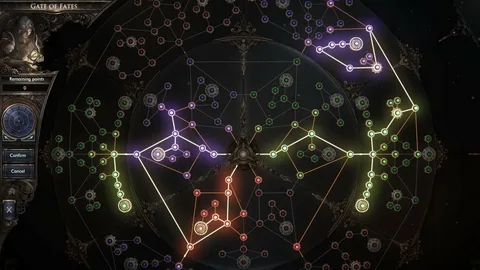Passive Tree in Path of Exile: A Beginner’s Guide
Embarking on your journey in Path of Exile, the Passive Skill Tree might initially seem daunting. However, with a bit of guidance, it becomes a navigable and integral part of your character’s development.
Understanding Skill Points
Each level up or completion of certain quests rewards you with Passive Skill Points. These points are crucial for enhancing your character’s abilities. You can accumulate up to 99 points through leveling and an additional 22 to 24 from quests, depending on your choices in the “Deal with the Bandits” quest. Mistakes are not permanent; you’re granted 20 refund points from quests to rectify any missteps.
Decoding the Skill Tree Structure
At first glance, the Passive Tree’s complexity may be overwhelming. To simplify, imagine dividing the tree into three segments, each representing one of the core attributes:
- Strength (Red)
- Dexterity (Green)
- Intelligence (Blue)
Each class in Path of Exile aligns with these core attributes. For instance, the Witch predominantly uses Intelligence (Blue) skill gems. Hence, in the tri-segmented Passive Tree, the Witch’s starting area is predominantly in the blue section at the top. This division provides a clear indication of which part of the tree will be most relevant to your character.
Utilizing Build Guides
As a beginner, following a build guide is highly advisable. These guides pre-determine the allocation of your Passive Skill Points, ensuring a balanced and effective build. Straying from the guide is not recommended, especially for new players. By adhering to these well-crafted plans, you can maximize the potential of your PoE currency and resources, leading to a stronger, more capable character.
Passive Skill Tree Nodes
Navigating the Passive Skill Tree in Path of Exile is crucial for enhancing your character’s abilities. The tree comprises various types of nodes, each contributing uniquely to your build.
Types of Nodes on the Passive Skill Tree
- Small Passive Skills
- These nodes provide incremental bonuses such as attributes, which are essential for equipping certain items and using skills. They act as stepping stones to reach other more impactful nodes.
- Major Passive Skills
- Situated typically at the end of a node cluster, these grant significant bonuses. Upon allocating a major passive skill, you gain access to a mastery bonus within that cluster.
- Masteries
- Unlocked through major passive skills, masteries offer specialized bonuses. Each mastery node presents a variety of options, but only one can be chosen per node. These bonuses vary based on the tree’s section, with some masteries appearing in multiple mod pools.
- Keystones
- Keystones are unique nodes that provide substantial boosts at the cost of significant trade-offs. While they can greatly enhance your build, it’s crucial to weigh their benefits against their drawbacks. Our build guides typically factor in these considerations.
- Jewel Sockets
- These nodes allow for the insertion of jewels, like the Ghastly Eye Jewel. Jewels, which can be either craftable rares or unique items, offer additional bonuses when socketed.
Refunding Passive Skills
Mistakes happen, and you might find yourself needing to reallocate passive points. You can use refund points earned from completing campaign quests for this purpose. If you exhaust these, Orbs of Regret can be used as an alternative, though they can be a scarce resource early in a league. Plan carefully to avoid unnecessary expenditure of these valuable items.
By understanding the different node types and their specific roles, you can more effectively plan and optimize your character’s build in Path of Exile. Remember, the Passive Skill Tree is a fundamental aspect of character development, and mastering it is key to your success in the game.
Final Tips
Remember, the Passive Skill Tree in Path of Exile is a powerful tool that shapes the strength and abilities of your character. Familiarize yourself with its structure and rely on trusted build guides to navigate it effectively. As you gain experience and confidence, you’ll find this once-intimidating tree to be a cornerstone of your Path of Exile adventure.
Conclusion
Navigating and mastering Path of Exile’s Passive Skill Tree is a journey of strategy and understanding, crucial for shaping your character’s strengths and gameplay style. Remember, each node, whether small or major, plays a vital role in enhancing your character’s capabilities. With this guide, you’re well-equipped to make informed decisions and explore the depth of customization that Path of Exile offers.
Your Next Steps in Wraeclast:
- Experiment with Confidence: Use the knowledge you’ve gained about different node types to experiment with builds. Don’t be afraid to try new combinations that suit your playstyle.
- Plan Your Build: Utilize tools like Path of Building to plan and visualize your Passive Skill Tree before committing in-game. This can save you time and resources.
- Stay Informed: Keep up-to-date with the latest patches and updates, as they can bring changes to the Passive Skill Tree and affect your build.
- Join the Community: Engage with the Path of Exile community on forums, subreddits, and Discord channels. Share your builds, get feedback, and learn from fellow Exiles.
- Keep Learning: Continue to refine your understanding of the game mechanics. The more you know, the better your builds will become.
- Have Fun: Above all, enjoy the process of building and playing your character. Path of Exile is a game of endless possibilities and adventures.
Ready to take your character to new heights? Dive back into Wraeclast and put your newfound knowledge to the test. Happy building, Exile!







